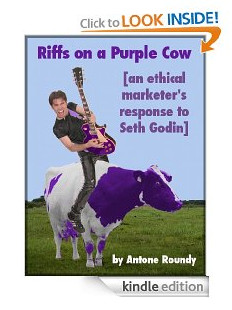When you purchase through links on our site, we may earn an affiliate commission (details)
Sales Letter Secrets from SpongeBob SquarePants
by Antone Roundy | 1 Comment | Copywriting
If you sit down with your child and watch SpongeBob SquarePants, you'll both laugh. But not always at the same time.
Why not?
Because some of the humor is too infantile for you. And some of it flies right over your kid's head. This isn't just true of SpongeBob. Lots of kids shows contain humor targeted at adults.
At the other end of the spectrum is Barney. I used to hate Barney with a passion. It's entirely targeted at kids, so there's nothing to interest me. Plus, his singing is worse than an American Idol audition.
(What eventually won me over to Barney was his power to keep kids entranced for extended periods of time. When you're a sleep-deprived parent, anything that can do that instantly becomes your friend.)
When you're writing a sales letter, odds are it's going to be read by a variety of people -- some highly educated. Others less so. So do you dumb your presentation down to the least common denominator?
No. You simplify. Which isn't the same thing.
Yesterday, Perry Marshall posted this on his blog:
One of my early mentors said, "When I write copy, I imagine Homer Simpson sitting on his couch. He's reading my letter after a long day at the nuclear plant. Not a smart guy. A dumb guy. DOH!"
There's truth there...
Still there's just a whole lot more to writing copy than assuming that "people are stupid."
...
"Plumbers won't understand if you write like a college professor "“ but professors will understand if it's plain to a plumber." Dr. Luther Brock said that, and he was right.
Simple is not dumb. Simplicity is the real mark of genius. E=MC2 may be the biggest discovery of the 20th century. Yet it's so short, even people who know nothing about science recognize it.
So step 1 -- the most important step -- is to express your idea simply. You don't dumb it down, you express is simply and clearly. This isn't just so that the "plumbers" will understand it. It also helps you get your point across clearly to the distracted, sleep-deprived "professors" (whose kids are in the next room watching Barney).
But once you've accomplished that, don't quit. Step 2 is to take a lesson from SpongeBob, and slip in some extra meat for the people who've got the experience, intelligence, and/or insight to recognize them.
The key is to avoid Barney's bad influence, and follow SpongeBob's good example (I'll be nobody's ever said that before!)
When Barney starts singing, the kids may love it, but anyone with half an ear for music cringes. Don't do that to your audience. When you add to your simple message, do it in a way that doesn't muddy things up for everybody else.
When SpongeBob makes a crack that flies over your kid's head, they don't get confused or bored and ask to change the channel. It just slips by unnoticed.
In your sales letter, you might use colors that some readers will associate with a product or company with a good reputation in your industry.
Or you might swap out a one-dimensional word or phrase for one that's equally understandable, but which, for some readers, is tied to a deeper reservoir of thoughts, feelings and experiences.
You might refer to events, movies, stories, etc. that illustrate the point you're trying to make. You don't have to tell the whole story to evoke the thoughts and feelings your readers already associate with it.
It all comes down to the KISS principle. "Keep It Simple, SpongeBob."





May 3rd, 2011 at 10:37 am
Great tips to keep in mind Antone, thanks. Slightly out of context, check out 'Kick Buttowski: Suburban Daredevil' for a laugh as well. A hoot for both parents and kids.